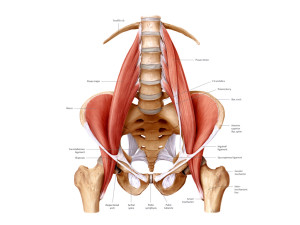One of my favourite muscles in the body, the Psoas has enormous influence on the bodymind. I’ve taken an extract from my course workbook and worked it into a blog post to give you an sense of how important and tricky this muscle is to work with:-
The Psoas and muscles of the pelvis provide movement and support for the whole of the body on a physical, emotional and psychological level.
What is its function?-
It is the muscle mainly responsible for lifting the femur in order for the leg to make a step forward. Energetically it would not be too bold to say that its movement creates the ability of the organism to progress through its life at all levels. I think of the psoas as the thirteenth organ. Looking at the meridians it follows the pathway on either side of the Chong Mai from Ren Mai/CV1 through to Du Mai /GV4 from where the belt channel originates and joins to CV6.
Where is it?-
The psoas is a large, thick, powerful bilateral muscle situated deep inside and mainly within the abdominal cavity. It runs from T12 diagonally over the pubic arch and inserts into the posteriomedial aspect of the lesser trocanter.
Contained WITHIN and on the muscle itself are the nerves of the lumbar plexus. The Psoas Major attaches to six vertebrae T12 to L5 and passes over two joints. It contracts and relaxes in sections depending on the work required of it. It is basically a hip flexor and encourages the FREE SWING of leg in walking and transfers weight through the trunk into the legs and feet. It is also like a guide-wire, a tensile structure, stabilising the spine.
It provides a shelf to support pelvic organs and viscera and it’s tone determines whether or not the abdomen has room for these organs.
The processes I use do more than strengthen or loosen. They create overall body awareness. This, more than any specific exercise allows the receiver to know whether what they are doing is beneficial for them.
So often we work on muscles that can be SEEN, to strengthen or relax them. For instance, we rarely if ever, exercise or even talk about the coccygeus muscle! Yet the muscles in the pelvis and psoas are “floor” to our bodies, antagonists to the diaphragm and throat.
Many back, knee, foot, shoulder and neck problems can be solved with correct attention to the functioning of this area of the body.
I like giving students tips on getting results fast for their clients but to date I have found no “quick fix” for this area. The simple fact is that years of bad habits are not changed quickly. People continue to do things that are bad for their bodies. It is not until they are compelled to recognise how uncomfortable their existence has become, that they sometimes do something about it. If they are ready to commit, just a little bit, the rewards are deep and lasting.
What I’m talking about is proprioception. Proprioception works not just in a physical, but also a mental, psychological and emotional way. A mind set can be changed but often it is a slow process and the client must be ready,on some level, for this change.
Teaching people to be aware of the psoas and pelvic muscles is like asking someone (who can do it) to describe how you lift your arm by activating different individual muscles. Try it sometime!
See if you can describe lifting a hot drink to your mouth by using individual muscles before the drink goes cold:
1. Tense the frontal fibres of the deltoid;
2. Relax the back deltoid fibres;
3. Tense the serratus anterior muscle; relax latissimus dorsi and teres major,
…and so on…
The interplay of muscles is complex, each muscle will hold movement memories of possibilities and restrictions which are good and bad, ie. its memory of R.O.M. (range of movement) and be limited by its A.M.B (anatomical motion barrier).
Now, translate this process to an area of the body which is just accepted as “being there”and rarely, if ever, specifically worked on.
The difficulties of getting clients and, even ourselves, to be body conscious are plain to see.

Thank you for a very interesting read and I totally agree on it’s significance in maintaining a healthy body and mind. In fact my path towards the necessity of body alignment and essentially pelvic alignment has cemented my belief that achieving pelvic alignment is a prerequisite in establishing good health..
I would be very interested in any future course covering this subject.
Best wishes and I look forward to hearing from you in the future.
Peter
Thanks Peter. I’m so glad I’m not ploughing a lonely furrow on this subject. It’s been a passion of mine for the best part of twenty years. I’ll let you know about details of the course next year when I have them.